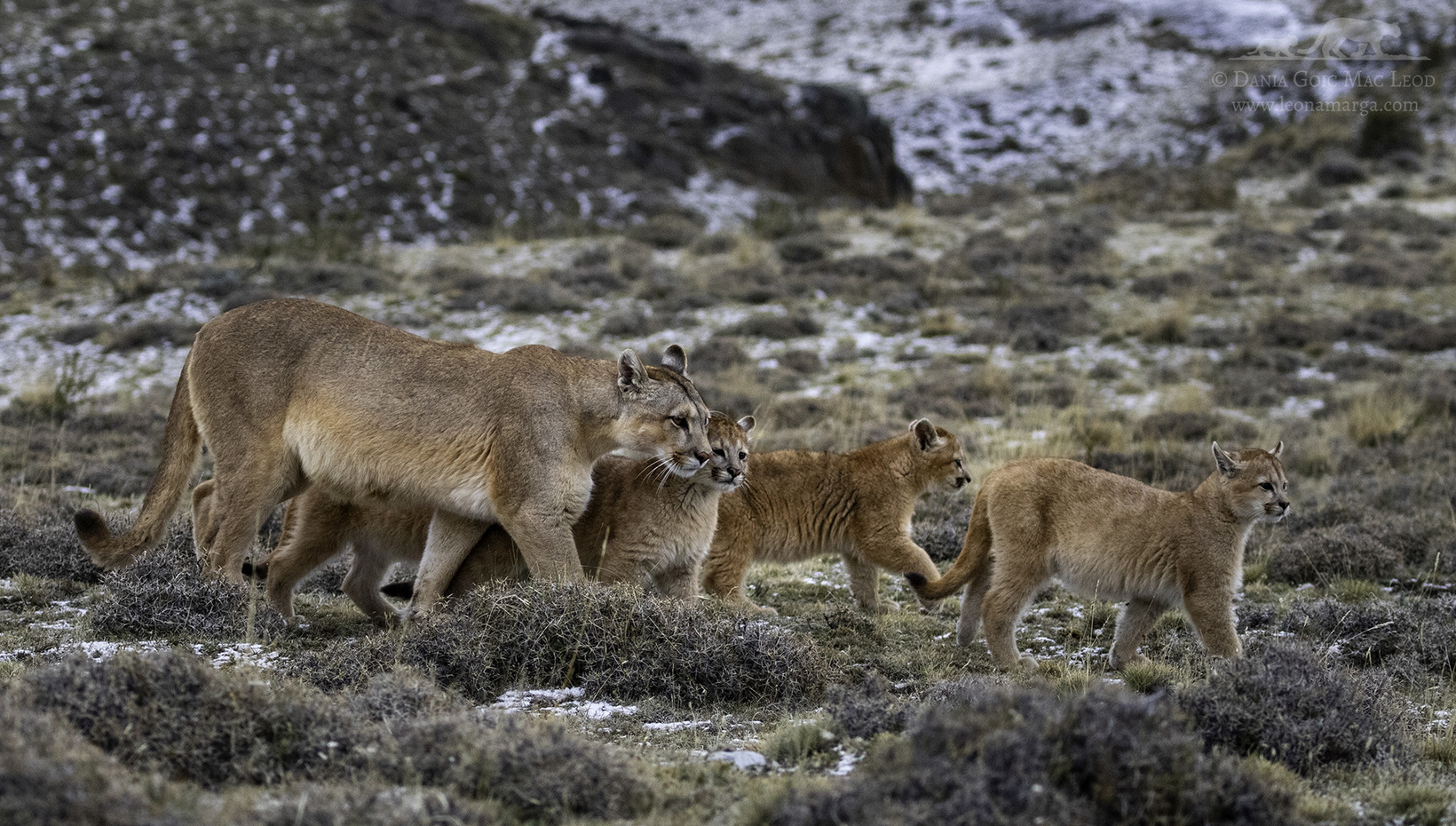Panthera is thrilled to announce our new partnership with Leona Amarga, the business entity that manages puma tourism on Estancia Laguna Amarga along the border of Torres del Paine National Park in southernmost Chilean Patagonia. Southern Patagonia is so far south that it is often referred to as the “End of the World.”. Together with Dania Goic and local guides, we are creating safety protocols for puma tourism, estimating local puma abundance, and expanding general knowledge of the region’s pumas.
A female puma and her four kittens strolled upslope and then disappeared over a rocky knoll, about 80 meters in front of us. Dania Goic waved us on and we walked forward, slowly. When we arrived at the spot where we watched the cats disappear, Mark Elbroch, Director of Panthera’s Puma Program, found their tracks in a skiff of snow, leading downward towards Lago Sarmiento. He indicated their direction to Dania.
Together we turned towards the lake and walked along a drainage filled with mata negra bushes, in which the cats may have retreated and within which they are difficult, if not impossible, to detect. We walked downhill for several minutes, scanning the landscape for movements that might betray where the family had gone. Then suddenly a kitten appeared on a rock, just 10 meters in front of us.
We froze, the kitten froze and we looked at each other. A second kitten appeared and the pair engaged in a short session of king-of-the-mountain, each jostling to hold the peak position atop the rock. A third kitten appeared to chase the other two, and then their mother climbed the slope with their last sibling. She assessed us calmly and then continued down the draw towards the lake, the kittens in line behind her. When they were a good 60 meters ahead of us, Dania turned to us and said, “Welcome to Laguna Amarga.”
How Laguna Amarga came to be a popular place to view wild pumas began as a tragic tale. Dania Goic and her twin sister Daneska, who currently lead Leona Amarga, are third generation Goic family. Dania’s grandfather established the estancia adjacent the eastern entrance to the National Park in 1976. Like all the local ranches at the time, they were primarily sheep ranchers earning their living by selling wool and Christmas lambs. All was well until the winter of 1995, when a catastrophic snow event hit the Magallanes province and killed approximately 80% of all the local sheep herds.
Some ranches never recovered and were taken by banks while others like Laguna Amarga managed to hold on. Dania’s father Tomislav Goic supplemented his income by becoming one of the original guides working in Torres del Paine National Park. Recognizing the uptick in visitors coming to visit the stunning Patagonia landscape, the Goic family built a small hotel and restaurant to cater to the vehicles streaming through their ranch to reach the Park entrance.
In 2005, a human-made fire swept the area, and burned half of Estancia Laguna Amarga, creating additional difficulties for the family and their recovering sheep herds. Soon after the fires, wildlife began to recolonize the ranch and because the sheep herds had been so reduced, the Goic family made no attempts to drive them back into the Park.
“Me and my sister wanted to take over the sheep business,” explained Dania, “but we realized that the wildlife had moved in and that continuing to raise sheep would be complicated. At the same time, we also realized that we were privileged to live in such a place surrounded by wild animals. We are a unique place, where visitors can observe wildlife in their natural environment. This is the only place in the world where you can actually observe pumas, and our ranch contributed to this phenomenon by helping the landscape and its wildlife to restore itself following years of sheep grazing and the devastating fire of 2005. Now, tourists are increasing in numbers every year.”
Today Estancia Laguna Amarga has been described as one of the most beautiful places on Earth. The Goic family and the guides that work on their property are doing something bold and beautiful. More than just initiating successful puma tourism, they are coexisting peacefully with pumas in a part of the world where conflict with sheep is still rampant, and pumas are frequently illegally killed in retaliation. The Goic family still raise sheep as well, but within a more holistic and sustainable framework, using livestock guarding dogs to protect their small flock from pumas.
Puma tourism is still in its infancy, and for this reason, fragile. If managed poorly, the backlash for pumas, local people and local economies could be drastic. But one cannot deny the incredible potential that puma tourism holds for challenging how we live with pumas everywhere. For this reason, Panthera has volunteered to provide what support it can to the Goic family, and aid Dania in creating safety protocols to protect people and pumas, and to help the Goic family and the guides that work their property learn as much about local pumas as they can.
“Personally, I think research studies are positive,” said an enthusiastic Dania, “and that they will provide us some guidance on how to do things on our ranch without impacting the wildlife. For example, we are now regulating puma tourism, and working with Panthera to certify guides in safety protocols. In this way, we hope to avoid irresponsible activities that might have negative consequences for pumas and those of us who live with them.”
Editor’s note: Join Dania Goic, Panthera biologist Mark Elbroch, and EcoTour Adventures next March for a once-in-a-lifetime experience with pumas on Estancia Laguna Amarga, as well as penguins and whales off the coast of southernmost Chile. There is still space!
